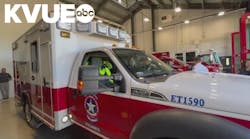As the turn of the century draws ever closer, those in the fire service EMS continue to wonder what the future may hold for pre-hospital care. As an integral component of the nation's ever-changing health care system, EMS professionals will most certainly feel the effects of managed care and the many other factors causing major health care corporations to be turned upside down.
Whether an agency is paid or volunteer, rural or urban, each should begin to embrace change and prepare for the future. EMS and the fire service have been built into well-respected, team-oriented cornerstones of America and deserve to be protected. Members from every level of an organization must work together to maximize their strengths, minimize weaknesses and make the most of the opportunities that are presented. Here is a list of 21 steps that can better position agencies for the challenges of the 21st century.
A Place To Start
1. Obtain the document EMS Agenda for the Future.
You may have heard of it or read it by now, but this document published by the National Highway Traffic Safety Administration (NHTSA) is an invaluable tool. It contains a blueprint of ideas on how to prepare organizations for future challenges (see the EMS column on page 18). Many specific ideas are offered on how to best deliver emergency medical services in the next century. It can be downloaded at http://www.nhtsa.dot.gov.
2. Begin with the end in mind.
In The Seven Steps of Highly Effective People, Steven Covey suggests that managers have an idea of what they hope to achieve before trying to accomplish it. Leaders should have a concept of where, in the best-case scenario, an organization should be in five years, 10 years, 20 years. A lot can change in a short time, including goals, but once these preliminary ideas are in place, a plan can be developed on how best to proceed.
Formulate A Strategy
3. Develop local and regional strategic plans for EMS.
4. Link strategic plans (in some way) to the budgeting process.
In the business world, a strategic plan is used to identify where a company is headed and what strategy will be used to get there. The same concept can (and should) be applied to fire and EMS organizations. This plan should focus on identifying the strengths and weaknesses within the organization, opportunities available and impending threats. A strategy can be developed to take advantage of strengths and opportunities while minimizing weaknesses.
A strategic plan is based on the overall mission, or master plan, of an organization. From that starting point, a detailed plan can be established with three major components:
- Long-term goals are needed to give an organization a general sense of direction. These are desired results sought to be achieved over a period of time, usually three to five years.
- Annual objectives must be developed as a set of more specific and measurable goals. These statements should describe what is expected on an annual basis to accomplish the overall strategy of the agency.
- Functional strategies identify activities that should be undertaken to meet the annual objectives. These are individual tasks describing exactly what needs to be accomplished to meet the annual objectives.
A strategic plan is a weak document unless its objectives are transformed into action items. The budget process should reflect the organization's strategy. The processes of developing the two may occur separately, but should eventually be linked as the blueprints of the agency's future.
Consider The Options
5. Consider public/private partnerships.
6. Do not reinvent the wheel.
While managed care makes its way across the country and into the different areas of health care, chiefs and administrators debate on how much to become involved with the managed care organizations (MCOs). One of the best ways to produce win-win situations is to enter into public-private partnerships. Combining thoughts and ideas with private agencies on transportation services or expanded scope of practice, for example, may be just the formula needed to ensure survival.
No matter what the issue, if you are considering starting a new program or revising an old one, find out what other agencies know about the subject. Sometimes neighboring agencies, large and small, can be incredible resources. Use the Internet, government agencies and networking with other EMS professionals from around the country to get as much information and perspectives as possible. And, one of the largest clearinghouses of fire and EMS references is the learning resource center at the National Fire Academy in Emmitsburg, MD.
Use Resources Wisely
7. Collaborate with medical control.
If a fire department is called to the scene of a working fire, the experts in the field are the firefighters there to handle any exposures or dangers that may arise. Conversely, if EMT/paramedics are called to the scene of a medical complaint, the experts remain the most highly trained medical professionals - physicians.
Whether licensed or certified, pre-hospital providers are linked as partners with emergency physicians who fill the role of medical control. Medical directors are helpful and essential members of the EMS team. The most successful EMS systems are those that collaborate and work cooperatively with medical direction.
8. Get involved in the legislative process at the local, state and national levels.
There are thousands of EMS providers in the nation. Collectively, this can be a significant and powerful political influence. Public safety professionals are, for the most part, well respected and listened to by legislators. The challenge is to offer a consistent, persistent message until it gets across and action is accomplished.
Know What's New
9. Initiate innovative methods of education and continuing education.
These days, it may take more than black-and-white overheads to keep the attention of a class. Utilize the tools of technology and incorporate them into continuing education. In addition, remember that variety is the spice of life - and education. Powerpoint presentations, CD-ROM interactive software, Web sites, and computer-generated simulation are only a few of the resources available.
10. Institute continuous quality improvement (CQI) programs.
Most have heard of the concept of quality assurance (QA). For years, QA has been performed on patient care, report writing and other field issues. In recent years, a better, more effective method has become popular.
Continuous quality improvement takes QA a step further and seeks not only to identify a problem, but to make appropriate changes to the system in order to correct the problem. It seeks to identify the root cause of a problem or situation and aims at preventing it from occurring in the future.
11. Subscribe to fire/EMS/ health care trade journals.
12. Attend fire/EMS/health care conferences and seminars.
So many factors and aspects of EMS are constantly changing that it can be difficult to keep up with what is going on in the world. One way to give it a good try is to subscribe to trade journals. And, when they come in the mail, do not let them sit on the counter - pick them up and read them!
Another way to keep up on what is happening in EMS is to attend the various conferences and seminars that are held throughout the country.
Educate The Public
13. Preserve the 911 system.
14. Promote and market services delivered.
15. Teach the public what EMS stands for.
There are not many things that society can count on with any degree of reliability. Public safety and the 911 system are two resources that communities have come to rely upon thousands of times per day. Strong effort must be made to keep the 911 system working effectively.
The importance of 911, EMS, health promotion and cardiopulmonary resuscitation (CPR) training should be emphasized. The benefits to having a functioning EMS system should be promoted and marketed to the community. Teach them not only what the letters stand for, but what it is that they mean.
Empower People
16. Empower members to do their jobs.
As change continues to overwhelm the workforce, innovative ways of delivering service will become necessary. To do this, the two main ingredients of empowerment, responsibility and trust, must be given to the front-line workers. No one will have a better idea of how things should be done than those who are doing the job. Supervisors should give responsibility to employees and trust them to do the job. An empowering manager will then stand back and serve as a resource, supporter, and source of encouragement.
17. Tear down the wall be-tween paid and volunteer.
Paid or volunteer, civilian or sworn, rural, urban or suburban, we are all in this together. Each of us must do what we can to foster the growth and improvement of this functional group without excluding or alienating anyone.
Embrace Technology
18. Look at incorporating technology into service delivery.
If present technology is any indication, the year 2000 and beyond will be filled with a cadre of advancements to enhance service delivery. Staying on the cutting edge of technology is the only effective way of competing and positioning for the future.
Make the best use of computers and the countless software programs available for word processing, presentations, graphics displays, database management and financial record-keeping. Some departments have a formal information technology plan to help guide them through this process.
And, Above All...
19. Go beyond tradition to eliminate the status quo.
20. Never lose sight of the mission.
21. Continue to provide the highest quality patient care.
Hundreds of years of tradition have built EMS into one of the most respected, effective career fields. EMS providers, public and private, have built on tradition to provide quality patient care. When, however, does such tradition end to make way for progress? Challenge your organization to rid itself of activities that have been done for years simply because "it's always been done that way." And keep the mission statement at the forefront of everything the organization does.
However the system in your area works, the priority is patient care. We must consider each and every person encountered in the course of a day or shift as a customer. In doing so, providing the best possible patient care means providing the highest-quality customer service possible.
Eric W. Heckerson, RN, MA, NREMT-P, is an EMS Specialist for the Mesa, AZ, Fire Department and is active in EMS program development and management at the local and state levels. He is a member of the adjunct faculty of Mesa Community College's EMT/Fire Science Department.






